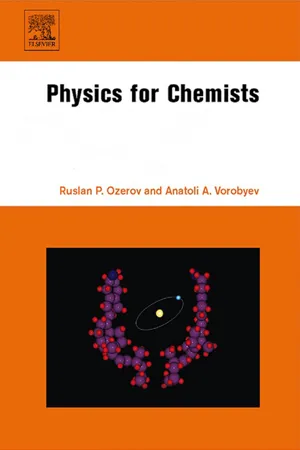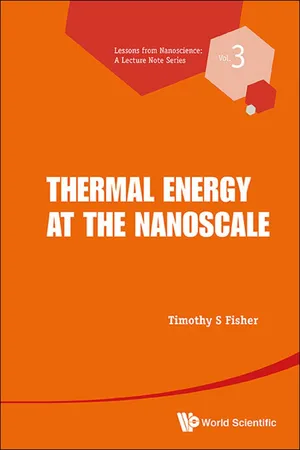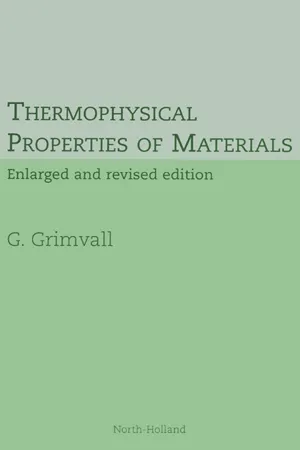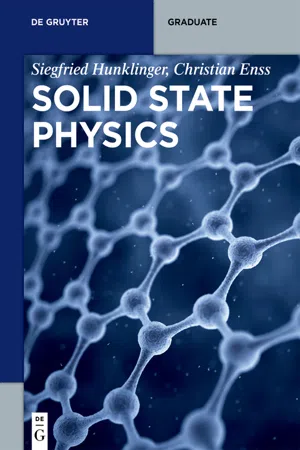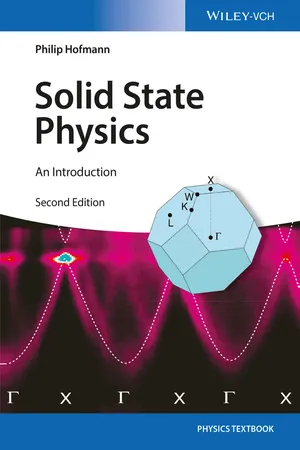Physics
Lattice Enthalpy
Lattice enthalpy is the energy required to separate one mole of a solid ionic compound into its gaseous ions. It is a measure of the strength of the ionic bonds within the crystal lattice. Lattice enthalpy values are important in understanding and predicting the properties of ionic compounds, such as their melting points and solubility.
Written by Perlego with AI-assistance
Related key terms
Related key terms
1 of 4
Related key terms
1 of 3
5 Key excerpts on "Lattice Enthalpy"
- eBook - ePub
- Ruslan P. Ozerov, Anatoli A. Vorobyev(Authors)
- 2007(Publication Date)
- Elsevier Science(Publisher)
collective excitations . Hence, in modern terminology, lattice heat capacity is a development of collective excitation in solids, i.e., the heat energy goes to phonon excitation (see below).Participation of electron excitations in heat capacity is limited by quantum statistics laws (refer to Section 9.2.2 ). As only a small part of the electrons takes part in excitation, the electronic heat capacity usually makes a very small addition in comparison with the lattice one.In a polycrystalline sample consisting of a large number of microcrystals, ideally—randomly dispersed in space—the resulting picture is averaged. As a result, the function g (ω ), presents the projection of all dispersion branches to the axis of frequencies (phonon spectrum). It describes the distribution of oscillations on frequencies: product g (ω )dω gives the number of oscillations dz falling on an interval dω . In Figure 9.19 the experimentally measured function g (ω ) for aluminum is given as an example.The fluctuation distribution function determines the internal energy of a crystal:U = ∫(9.3.7)ɛ ¯g( ω )d ω ,(9.3.7)whereɛ ¯is an averaged oscillation energy.The dispersion curves and g (ω ) function can be obtained by neutron scattering methods.9.3.2 The heat capacity of crystals
Heat capacity was introduced in Section 3.4.3 as the heat energy capable of heating a body by 1 grad. For an ideal gas in molecular kinetic theory the mole heat capacity appeared to be equal toC V=R andi ef2C p=R ,2i ef+ 2where i ef is the effective number of a gas molecule’s degrees of freedom. In this case i ef turns out to be the sum of translational, rotational and oscillation movements; in the latter i ef, osc = 2 because oscillation simultaneously possesses potential and kinetic energy.Apply these representations to a solid. For this purpose we should first analyze the character of possible movements of the molecules in it. Clearly, translational motion is excluded in this case. The rotation of molecules in a crystal is basically possible. For example, in crystal NH4 Cl a group NH4 + - eBook - ePub
- Timothy S Fisher(Author)
- 2013(Publication Date)
- WSPC(Publisher)
The study of thermal energy in any material should rightly begin with a description of the material itself, for thermal energy, unlike other forms of energy such as optical, electronic, and magnetic, is routinely generated, stored, and transported by a diverse set of ‘carriers’. The reason for broader context of thermal energy derives from the second law of thermodynamics, which dictates that all forms of energy tend toward disorder (or ‘thermalization’). In this text, we will make every reasonable attempt to unify the analysis, i.e., to generalize concepts so that they apply to multiple carriers, but this objective is occasionally elusive. In such cases, the text will make clear the relevant restrictions by carrier and material types. The list of interesting materials and physical structures is almost endless, and therefore given the subject of ‘nanoscale’ physics, the text begins with an admittedly cursory treatment of interatomic bonding but then highlights where possible a compelling structure — the graphene carbon lattice — to illustrate important and unique thermal behavior at the nanoscale.1.2 Atom-to-Atom Bonding in Solid LatticesThe details of interatomic bonding determine a broad assortment of physical material properties, ranging from mechanical strength to electrical conductivity. The primary interest here relates to the resultant vibrational characteristics of atoms that exist in an ordered arrangement, i.e., in a regular crystal. However, we start with a simpler situation: that of a diatomic molecule.Figure 1.2 shows a schematic of two atoms separated by an equilibrium distance r = r0 about which the atoms vibrate at various (but restricted) frequencies. A generic potential energy field U(r) between the atoms is shown in the bottom half of the figure, revealing the strong repulsive force (F = –∂U/∂r) when the atoms are close together (r < r0 ). The minimum energy (at r = r0 ) corresponds to the bond energy, as the potential energy asymptotes to zero when the atoms are pulled apart (r - eBook - ePub
- G. Grimvall(Author)
- 1999(Publication Date)
- North Holland(Publisher)
CHAPTER 7THERMAL PROPERTIES OF HARMONIC LATTICE VIBRATIONS
1 Introduction
Lattice vibrations give the key to many temperature dependent properties of solids. If we know the quantum mechanical energy eigenvalues of these vibrations, we can easily model thermodynamic quantities such as the Gibbs energy and the heat capacity. If we also know the eigenfunctions corresponding to the eigenvalues, we can calculate, e.g. the vibrational displacements of the atoms and connect that to properties such as the electrical resistivity. In applications to materials science the temperature is often so high that a classical description agrees very well with the more fundamental quantum mechanical approach. We therefore start with a brief comparison of these two descriptions.Consider a one-dimensional oscillator in classical mechanics. If the restoring force constant is k , and the mass is M , the frequency is(7.1)The potential energy E pot is(7.2)The equipartition theorem says that, in thermal equilibrium, the potential energy and and the kinetic energy are equal;(7.3)Here “ − ” denotes thermal average. It follows that the thermally averaged squared displacement is(7.4)The heat capacity C = ∂E/∂T is(7.5)The absolute value of the Helmholtz (free) energy F = E − TS is undefined since classical physics only deals with entropy differences and not their absolute values.These classical properties can be contrasted with the quantum mechanical description. There the Helmholtz energy can be obtained as(7.6)Z is the partition function, containing a sum over all quantum states i with energiesEi;(7.7)In our case with a single oscillator, the quantum energies are with n = 0, 1, 2, 3, …, and Z takes a simple closed form;(7.8)which yields(7.9)From a knowledge of F = E − TS , ordinary thermodynamics gives, e.g. the energy E and the entropy S. The third law of thermodynamics implies that S = 0 at T = 0 K, and the entropy has a well-defined value. There is also an “equipartition” theorem for each quantum state of a harmonic oscillator, saying that the expectation values and of the potential and kinetic parts of the Hamiltonian H - eBook - ePub
- Siegfried Hunklinger, Christian Enss(Authors)
- 2022(Publication Date)
- De Gruyter(Publisher)
7 Lattice AnharmonicityWhen discussing the lattice dynamics of crystals above, we have implicitly assumed that atoms move in a strictly harmonic potential and therefore perform harmonic oscillations. In this idealized concept, the coupled motion of the atoms can be broken down into normal modes that do not interact with each other. If this were indeed the case, it would not be possible to bring a non-equilibrium distribution of the phonons into equilibrium. It is only the anharmonicity of the crystal lattice that enables thermal equilibrium to be reached. Furthermore, the anharmonicity also manifests itself in many other solid state properties, for example in thermal expansion, finite thermal resistance, ultrasonic absorption or the various values of adiabatic and isothermal constants.In principle, the non-linear properties can be described by taking into account higher-order terms in the expansion of the potential function of the lattice. This typically results in expressions that are so complicated and confusing that it is difficult to calculate concrete properties. Furthermore, the large number of material constants that follow would also be difficult to determine experimentally. Nevertheless, in order to develop a certain “feeling” for the important property of anharmonicity, we will go ahead and describe the thermal expansion and the interaction between the phonons phenomenologically, avoiding the analytical path via the development of the potential function to higher orders.7.1 Thermal Expansion and the Equation of State
Thermal expansion implies the deviation of the lattice potential from the purely harmonic form because, as we shall see, the volume of a solid would be independent of temperature without the anharmonicity. The link between the sample volume and temperature means that important thermodynamic quantities such as internal or free energy also depend on sample volume.Here we take a closer look at thermal expansion. First, we derive the equation of state for solids. In the absence of adequate microscopic models, we use a phenomenological approach proposed by E. Grüneisen1 - eBook - ePub
Solid State Physics
An Introduction
- Philip Hofmann(Author)
- 2015(Publication Date)
- Wiley-VCH(Publisher)
4 Thermal Properties of the LatticeIn this chapter, we discuss some thermal properties of solids such as their heat capacity, thermal conduction, thermal expansion, and melting. For now, we only consider the contribution of the lattice, that is, the effects caused by the motion of the atoms around their equilibrium position. For some thermal effects, the motion of the free electrons in metals can be very significant (e.g., thermal conduction), but we neglect this for now and come back to it in the next two chapters.4.1 Lattice Vibrations
The atoms in a crystal can vibrate around their equilibrium position. The restoring force can be derived from the interatomic potential, as expressed in the Taylor series (3.11 ). In most cases, it is sufficient to assume a linear restoring force, considering only the first three terms in the series. This leads to a description of the lattice vibrations as harmonic oscillators and is therefore called the harmonic approximation.4.1.1 A Simple Harmonic Oscillator
When inspecting the interatomic potential in Figure 2.1 and the Taylor series for the potential (3.11 ), one might be tempted to describe the vibrations of a solid with N atoms simply as 3N independent harmonic oscillators. The factor of 3 comes from the three different directions the atoms can oscillate in. While this is clearly much too simple (the oscillators are all coupled to each other), it is surprising how far one gets with this picture.If the force constant is equal to in (3.11 ) and x is the displacement from the equilibrium position (for convenience, we set the origin of the coordinate system such that a in (3.11 ) is zero), the equation of motion is4.1where M is the mass of the vibrating atom. This leads to a harmonic motion with the frequency 1
Index pages curate the most relevant extracts from our library of academic textbooks. They’ve been created using an in-house natural language model (NLM), each adding context and meaning to key research topics.
Explore more topic indexes
Explore more topic indexes
1 of 6
Explore more topic indexes
1 of 4
